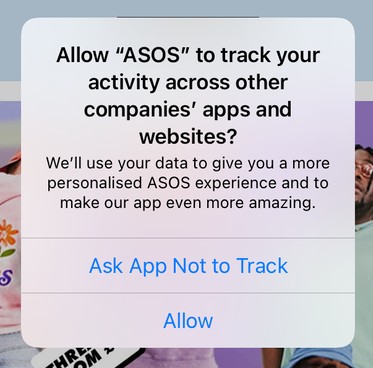How does iOS 14.5 affect digital marketing?
In iOS14.5, permission to access Apple’s identifier for advertisers (IDFA) has changed from opt-out to opt-in.
IDFA is a unique ID for an iOS device, and has been the key to tying a user’s identity and demographics to their actions across apps and the app store.
Apps that want to access IDFA to send to another company for targeting or attribution will need to use iOS’s App Tracking Transparency (ATT) prompt to request consent from the user. They will also need specific details in their privacy policy, and have a mechanism to delete data on request by the user.

The ATT prompt isn’t very customisable, so expect apps to pop up an explainer screen outlining the value to the user before requesting consent. A community-driven gallery website has spun up, trying to gather as many ATT prompt examples as possible, and is a great place to see how different brands are approaching messaging.
What's the impact on marketing data?
The impact is pretty massive!
Flurry, a Verizon-owned analytics agency, found just 5% of iPhone users in the U.S. have agreed to app tracking after updating to iOS14.5.
Data about ad clicks leading to app downloads won’t be sent to ad services until the app is installed and opened for the first time.
Web conversion data will be sent at the time of conversion and not at the time of ad click, which is a different time window to how ad clicks have been reported historically.
Apple’s SKAdNetwork will report aggregated results at the campaign level, and may use statistical modelling at the ad set and ad levels.
Facebook campaign reports won’t support drilling down on results by age, gender, region, or placement. The default 28 day click attribution window has changed to a 7 day click window.
The size of Facebook audiences for ad targeting are likely to decrease.
You’re still able to build GA audiences from users with ads personalisation enabled on their Google accounts, and publish remarketing ads to the app ecosystem via the Google Display Network. The app which is publishing the ad needs to collect ATT consent before the ad will be shown to the user. In this sense, ATT doesn’t impact the creation of GA remarketing audiences, but will impact the ad inventory available.
As smaller affiliate networks become unviable, demand for Google and Facebook ad inventory will increase. As supply becomes constrained, it’s likely that ad cost will increase.
What's the impact on analytics data?
The good news is apps which send data to Google Analytics are unaffected for event logging, event reporting, and conversion measurement – but attribution will be impacted if the user opts out of tracking.
In Google’s response to iOS14.5, they encourage app advertisers to upgrade to the latest version of Google Analytics for Firebase for new features like SKAdNetwork support.
The main apps affected by iOS14.5 are those which send data to Facebook and Google Admob.
Websites which use the Facebook pixel are unaffected as the change only impacts apps, not web browsers.
Facebook’s app itself doesn’t need IDFA as they use their own first party data to identify users and therefore doesn’t need to display the ATT prompt, and ads in the newsfeed will be unaffected. Facebook’s audience network, which allows you to target users based on their demographics and behaviour on other websites by utilising IDFA, will likely shrink in size.
Mobile Measurement Partners (MMPs) such as AppsFlyer have relied on IDFA to understand the performance of campaigns on ad views, clicks, app downloads and installs. They won’t be able to continue to have access to this data unless users agree to app tracking.
In response, AppsFlyer are following the lead of Apple’s own SKAdNetwork service by shifting from deterministic models which require identifying specific users, to probabilistic models which optimise campaigns based on aggregate performance. We expect this approach will be widely adopted by other MMPs.
What can app owners do?
Where possible, using your own first party data to identify users and syncing this with the ad networks will be a solid strategy to retain visibility of conversions and accuracy of targeting for your known users.
Server-side tracking is another way to reduce analytics reliance on technologies which are being impacted by increased user privacy considerations, as data is collected in a first party context and allows for methods like cookie-less analytics tracking.
Google also recommends including the latest Google Analytics Firebase SDK in your iOS app to enable SKAdNetwork support and to prepare for future changes from Google.
As always, DataTribe recommends informing users on what data is being collected and how it will be used, and conforming to your users privacy and consent choices.